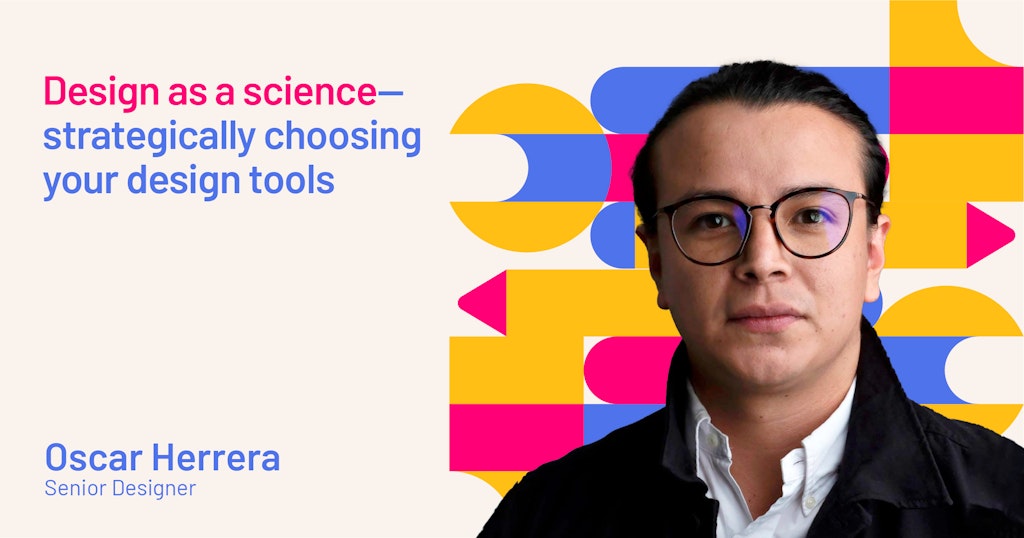Design as a science—strategically choosing your design tools

Like creativity, design is often misunderstood as something “magic” that exists independent of strategy, processes and systems. This misunderstanding frames design as something that subjectively “clicks” with audiences and, whether unique circumstances or talent generate the creative ideas, suggests that replicability isn’t part of the equation. But that’s not the case—especially not for brands.
Not only is design entwined with strategy, but it’s also strategy that leads to impactful and replicable design. In fact, it’s a clear strategy that provides brands with their initial baseline or purpose to evaluate and improve on their design systems and tools.
Below, we’ll explore how brands should approach design from this perspective to achieve their strategic goals.
Defining design
Design is two things:
- It’s the set of tools used to answer a strategic need for a given audience or market.
- It’s the scientific and analytical process that wields creativity with purpose to perform a specific function or job for the brand.
But when people think of design, they sometimes regard it as simply the outcome of the above, leading to the misunderstanding that it’s magic or separated from strategy.
In comparison, cooking isn’t a finished dish but rather the purposeful combination of flavors, textures, techniques and the other culinary processes or characteristics that produced it. Every element is used to achieve the result. To take the analogy further, suppose a restaurant is known for a specific type of cuisine. Straying from that cuisine’s primary ingredients and techniques (without purpose) will result in unpredictable outcomes and will differ from what diners were seeking.
In contrast, the creative and purposeful use of those ingredients and techniques helps deliver on the restaurant’s strategy of serving a specific cuisine and achieving new heights or unique versions of a dish that customers can’t get from any other restaurant.
Likewise, every iteration of a design tool carries meaning or connotations; using one that doesn’t contribute to the final result in a way that aligns with brand strategy hurts or confuses the outcome. And because design is a set of tools and a process, your brand can continually optimize it to improve performance (i.e., the expression of brand meaning in a manner that resonates with target audiences and further strengthens their relationship with the brand).
Every design tool has a job.
A design “toolbox” includes elements such as:
- Naming conventions
- Logos
- Colors
- Typography
- Iconography
- Imagery
- Motifs
These tools individually incorporate numerous iterations used to convey something about the brand. For example, typography includes different fonts that affect how target audiences perceive (or recognize) the brand and its messaging—from professional to casual, exciting to calming, and more.
Since these design tools and their iterations convey specific meanings and associations, if a brand’s design systems lack the right ones or they’re used without purpose, it detracts from an engagement or experience. The meaning becomes unclear to the audience or loses its impact.
Deciding which iterations of various design tools your brand should use first requires establishing brand strategy. Otherwise, those decisions lack both purpose and objectivity, becoming a result of subjective preference. Strategy provides the orientation and baseline for evaluating each of these choices and producing engagements.
Do they align with your “expression attributes” (i.e., the three to five words that best describe a brand’s meaning)? Do they fulfill a job delivering on those attributes in a specific activation? Is it worth the resource investment to use specific design tools?
The value of specific design tools and “white space”
Every design tool a brand uses should be evaluated for its specific strategic value and the opportunity it provides. Uncontested opportunities generally provide brands with the greatest strategic value because they allow your brand to stake a claim on specific design elements to stand out from your competitors.
For example, John Deere “owns” green when it comes to tractors. The color serves as a key brand identifier and differentiator. So, other outdoor power equipment manufacturers avoid green because it directly competes with an industry giant that has invested significant resources and launched innumerable activations to stake its claim on that specific design tool.
Brands can always challenge claims like these, but that requires sufficient investment in strategy, design tools and activation campaigns to be successful. Instead, it’s generally easier and a better use of resources to claim and defend another color—one within the “white space” left by other competitors.
Of course, brands might determine that a competitor’s claim on a given design tool is vulnerable, and challenging it is worthwhile. In this way, brand strategy’s influence on design systems and tools also serves as a resource allocation guide based on what the brand can best defend or challenge.
The strategic alignment of design tools
Strategic considerations for design tools go well beyond what’s available or vulnerable. Just because an opportunity exists doesn’t mean it will benefit the brand—especially if the design tool doesn’t align with what the brand means to customers or its chosen expression attributes.
For example, many companies use stock photos for their digital presence imagery. However, if your brand (or employee value proposition) emphasizes that you have the most friendly, knowledgeable and supportive team, using stock photos might lessen the impact of that messaging. Instead, creating a media library of professionally photographed employees at on-site locations better communicates that aspect of the brand.
Objective design decision-making for systems and tools
These strategic considerations not only facilitate design decision–making, but also ensure the most objectivity possible. Rather than the subjective preference of various stakeholders, different iterations of design tools either do or don’t deliver on a brand’s expression attributes and defend or challenge a claim better than others.
Additionally, building a selection of the most strategically aligned design tools (i.e., the brand’s design system) enables a brand to consistently replicate the same, recognizable meaning throughout all engagements.
Every brand needs design
Design provides organizations with the tools and processes they need to inspire and leverage creativity in pursuit of strategic outcomes and meaningful relationships with their audiences. And because strategy is so entwined with brand design, organizations can objectively determine the best design tools to achieve those outcomes (via methods such as swarming and co-creation).
Even brands that don’t consider themselves “design-led” need to evaluate their strategy to decide whether their systems and specific tools effectively communicate what the brand means and prove a worthwhile investment.

